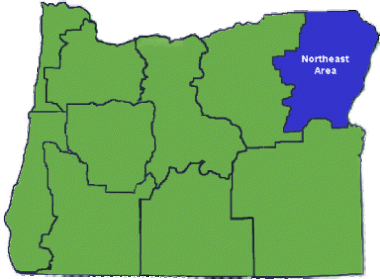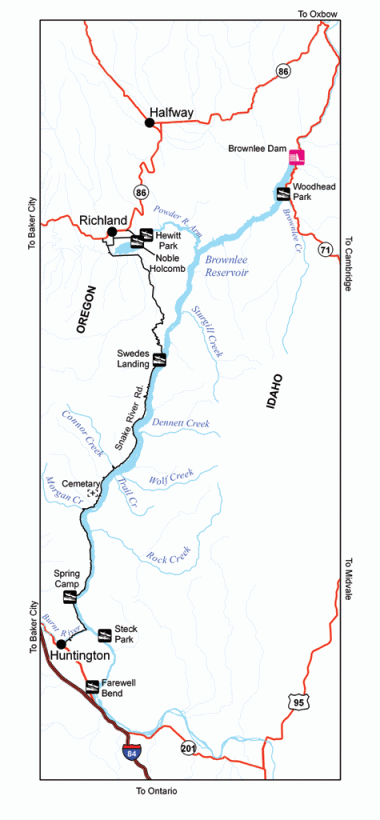
Warmwater fishing in northeast Oregon
Most warmwater anglers traveling to the northeast area are probably heading to Brownlee Reservoir, a huge 15,000 acre waterbody located along the Oregon-Idaho Reservoir on the Snake River. Brownlee offers outstanding fishing for bass and catfish, but might be best known for its crappie fishery which attracts anglers from throughout the country. However, anglers shouldn't overlook the other fishing opportunities located further downstream below Brownlee in Oxbow and Hells Canyon Reservoirs, and in the Snake River itself. Even in the lower Grand Ronde, a river better known for trout and steelhead, anglers will find good smallmouth bass fishing during the summer. For those wanting to fish smaller waters, Unity Reservoir located just north of the small town of Unity also offers good fishing for crappie as well as bass.

Warmwater fish found in the northeast area include: Largemouth Bass | Smallmouth Bass | Bullheads | Black Crappie | White Crappie | Bluegill | Pumpkinseed | Yellow Perch | Warmouth | Channel Catfish | Walleye
Featured waterbody - Brownlee Reservoir
Brownlee is a nearly 60-mile long Snake River reservoir on the Oregon-Idaho border that offers an excellent warmwater fishery for a variety of species including crappie, smallmouth bass, channel catfish, bluegill, and perch. It is jointly managed by ODFW and Idaho Fish and Game, but you'll only need an Oregon or Idaho license to fish much of Brownlee. The exception is the Powder River Arm located on the reservoir's west side where an Oregon license is required.
Boating is a great way to explore Brownlee, but water levels can fluctuate dramatically through the year so be sure to check on current levels and availability of ramps. The general consensus among anglers is that the water needs to be up and stable for a couple of weeks for the best fishing.
For the bank angler, access is also very good. The Snake River Road is a well-maintained gravel road on the Oregon side of the reservoir between Spring Camp Recreation Area and Swede's Landing. Along it are many pullouts and undeveloped areas that provide access, but there is very little shade or cover from the sun or dust so be prepared. There are no commercial facilities at Brownlee, but visitors will find several public parks and campgrounds, and many undeveloped camp sites.
When to fish
Spring is the best time to fish for crappie and bass. Summer is best for catfish. Fishing is best in the early morning or evening.
Where to find fish
The bays formed at the mouths of some of the major tributaries to the reservoir (Morgan, Brownlee, Conner, and Sturgill Creeks and the Burnt River) as well as the Powder River Arm and Snake River are the best places to find all species of fish in the reservoir. Catfish tend to be more abundant in the upper third of the reservoir, while bass fishing is fairly good on either shore between Morgan and Conner Creeks. However, any bay or rocky outcropping other than cliff faces will generally provide habitat to fish and offer a good fishing location. Fish 20-30 feet from the shoreline in water 8- to 30-feet deep in these locations and you'll generally be in the fish.
Technique for crappie
Use an ultralight rod and reel with 2-to 4-pound test line. You can catch crappie throughout the year, but they're much more accessible in June and July when they move into shallow water to spawn. At other times of the year, pre- or post-spawn, the fish will be in 30-35 feet of water and you'll have to actively jig for them. When they're shallow, you can use a bobber and skirted lead-headed jig rig with about 8-9 feet of line below the bobber. Local anglers favor red-bodied/white-tailed tube jigs and white or chartreuse jigs flecked with sparkles. If you use two hooks on your crappie rig use a 1/32-ounce jig head on the bottom and a 1/16-ounce jig head on the top. Try one of the patterns mentioned above on one of the jigs and experiment with other colors on the other. Remember, clear or light colors generally work best when the water is clear and dark colors work better in dark water. You can also increase your chances by baiting the hook with crappie nibbles, worms or grubs.
Technique for bass
Best fishing is from a boat; target rocky points, rock piles, or drop-offs that are hard to reach from shore. Use a light rod and reel with 4- to 6-pound line. As with crappie, bass can be caught year-round, but they're much more accessible in the spring (May-June) when they move into shallow water to spawn. At this time, bass also tend to be fairly aggressive, so they'll strike at anything moving in their vicinity such as tube jigs, spoons or grubs. Try casting a crappie jig with a big curly tail and metal flakes into shore and let it bounce down the bank. The color rule for crappie - clear/light colors for clear and dark colors in dark water – also generally applies to bass. Smallmouth will typically be found in less than 20 feet of water, larger fish tend to be deeper, but will move into shallower areas as it gets dark or when shade hits the water.
Technique for catfish
Use a medium-weight rod and reel with a 10- to 12-pound test line. Use heavier line if you're fishing in the weeds in the Powder River arm. Use a slip sinker or bobber baited with worm, raw shrimp tail, raw chicken livers, stink bait, dead bait fish or crickets. In summer, locals prefer fishing a bobber setup fished just off the bank with 2-4 feet of line between the bobber and bait.



